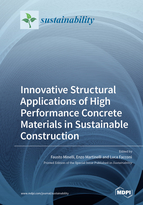Innovative Structural Applications of High Performance Concrete Materials in Sustainable Construction
A special issue of Sustainability (ISSN 2071-1050). This special issue belongs to the section "Sustainable Engineering and Science".
Deadline for manuscript submissions: closed (30 June 2021) | Viewed by 30941
Special Issue Editors
Interests: FRC and HPC materials; shear behaviour of members without transverse reinforcement; structural applications of FRC; structural retrofitting; masonry; RC; buildings and bridges; innovative materials; finite element analysis; construction engineering; civil engineering materials; alkali activated materials
Interests: structural analysis and design; structural concrete; seismic assessment and retrofitting; sustainable cementitious composites
Special Issues, Collections and Topics in MDPI journals
Interests: Fibre Reinforced Concrete (FRC); structural rehabilitation; geopolymers; alkali activated materials; structural analysis and modelling
Special Issue Information
Dear Colleagues,
Sustainability is recognised nowadays as an essential requirement for any human activity. Making it achievable in energy- and material-intensive sectors, like the construction industry, still needs dedicated research efforts on building material technology. The present Special Issue is comprised of the application of sustainable materials, technologies, and strategies to new and existing structures.
For existing structures, structural and energy retrofitting are of paramount significance in the modern society; an integrated approach needs to be followed with the aim to achieve both retrofitting objectives in a synergistic way.
Moreover, advanced and innovative design solutions, analytical models, material investigations in terms of short and long-term behaviour, with their influence at structural level, have to be provided for new constructions.
The need for developing innovative, sustainable and cost-effective solutions are therefore rather significant.
The use of high-performance cementitious (or similar, such as alkali-activated) materials seems to be rather promising in this context, as it implies, among other things,
- Limited consumption of raw materials,
- Smaller cross sections in new construction,
- Reduced thicknesses in overlays for the strengthening of existing reinforced concrete/masonry structures (columns, masonry walls, floors),
- Reduction of the seismic demand in retrofitting interventions, etc.
The use of recycled materials, if well designed, could also lead to innovative high performance sustainable solutions.
Contributions on the following topics to this SI are welcome:
- Innovative high-performance materials for new and existing structures
- Innovative sustainable techniques for new and existing structures
- Structural applications of high- and ultra-high-performance fibre reinforced concrete (HPFRC and UHPFRC)
- Structural applications of alkali-activated materials (AAM)
- Analytical studies for the optimization of effectiveness, costs, and impact of innovative materials in new and existing structures
- Analytical models of innovative materials at structural level
- Code provisions and adaptation of current available models to new materials
- Evaluation of combined solutions of innovative and sustainable materials/techniques for structural and energy retrofit
- Case studies
Prof. Dr. Fausto Minelli
Prof. Dr. Enzo Martinelli
Prof. Dr. Luca Facconi
Guest Editors
Manuscript Submission Information
Manuscripts should be submitted online at www.mdpi.com by registering and logging in to this website. Once you are registered, click here to go to the submission form. Manuscripts can be submitted until the deadline. All submissions that pass pre-check are peer-reviewed. Accepted papers will be published continuously in the journal (as soon as accepted) and will be listed together on the special issue website. Research articles, review articles as well as short communications are invited. For planned papers, a title and short abstract (about 100 words) can be sent to the Editorial Office for announcement on this website.
Submitted manuscripts should not have been published previously, nor be under consideration for publication elsewhere (except conference proceedings papers). All manuscripts are thoroughly refereed through a single-blind peer-review process. A guide for authors and other relevant information for submission of manuscripts is available on the Instructions for Authors page. Sustainability is an international peer-reviewed open access semimonthly journal published by MDPI.
Please visit the Instructions for Authors page before submitting a manuscript. The Article Processing Charge (APC) for publication in this open access journal is 2400 CHF (Swiss Francs). Submitted papers should be well formatted and use good English. Authors may use MDPI's English editing service prior to publication or during author revisions.
Keywords
- FRC (Fibre Reinforced Concrete)
- UHPFRC (Ultra High Performance Fibre Reinforced Concrete)
- AAM (Alkali Activated Materials)
- RC (Reinforced Concrete)
- Retrofitting
- Energy efficiency
- Sustainability
- Low-impact interventions








